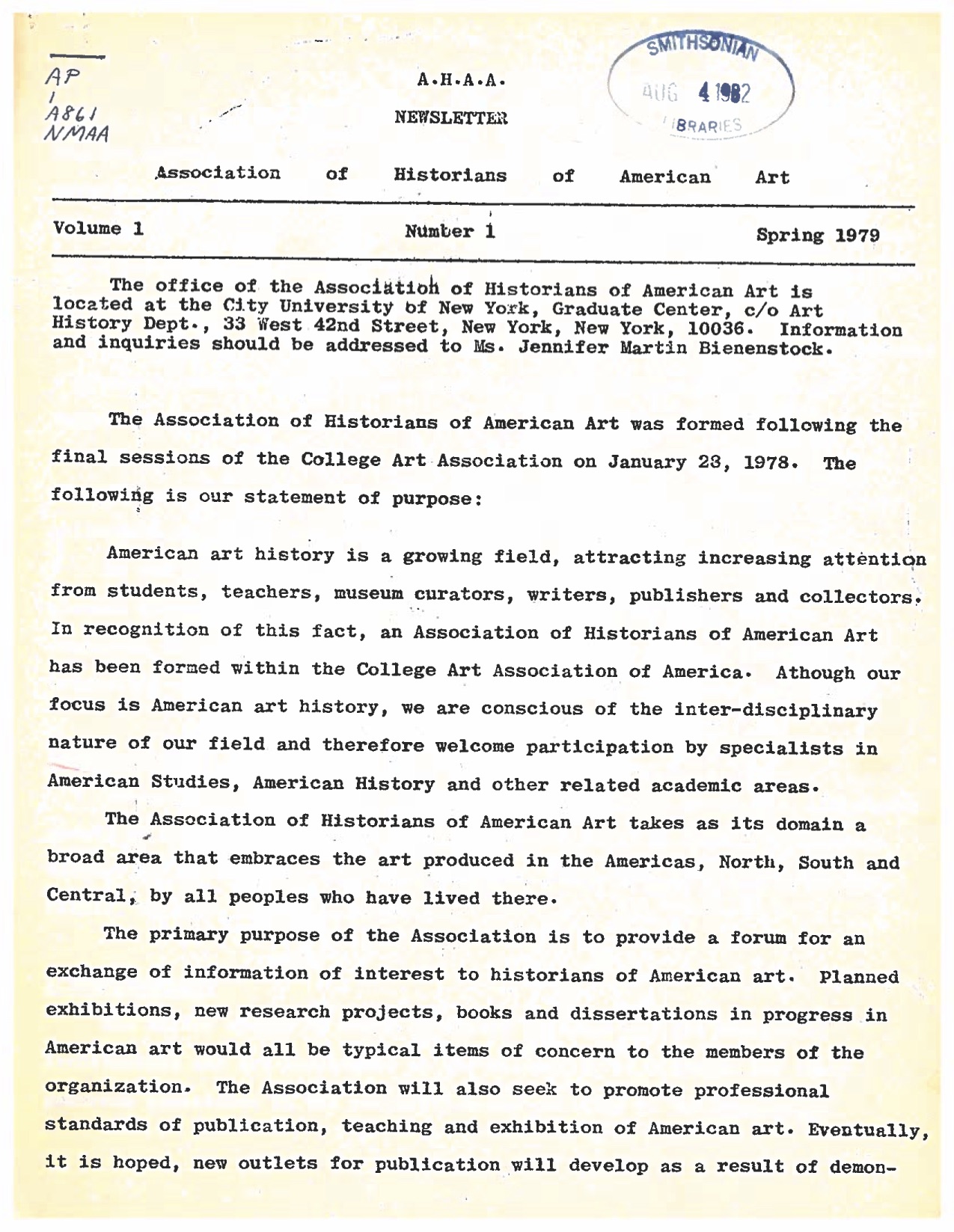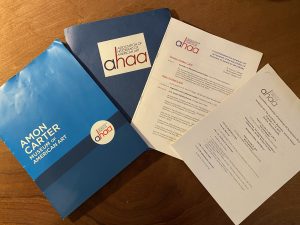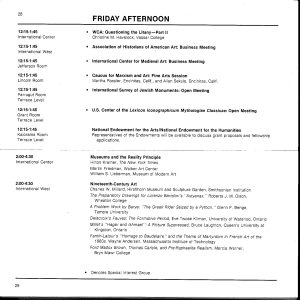Who Will We Be? The Association of Historians of American Art on its Fortieth Anniversary
Guest Editors

Since its inception four decades ago, the Association of Historians of American Art (AHAA) has embraced a broad, actively inclusive, inherently collaborative mission for the field of American art. In its first newsletter (fig. 1), published in spring 1979, the organization described its “domain” as “the art produced in the Americas, North, South and Central, by all peoples who have lived there.” That AHAA saw its founding responsibility as telling the history of “all peoples who have lived” in the Americas—within and beyond the geographical confines of the United States—seems a prescient vision forty years later, when our field has come to demand transnational, intersectional accounts of American art that also address our nation’s histories of settler colonialism. Of course, as this introduction and our seven respondents indicate, grappling with how best to fulfill this vision is a task AHAA continues to pursue—and one we cannot accomplish alone.
Contributors
David M. Sokol
Wanda M. Corn
Teresa A. Carbone
Peter John Brownlee
Ellery Foutch
Gwendolyn DuBois Shaw
Alicia Harris
Plus: AHAA Members on Our Fortieth Anniversary
In the late 1970s and 1980s, at a time when relatively few universities offered programs in American art, AHAA’s interdisciplinary cohort of art historians and scholars of American Studies and American history endeavored to be an invigorating and connecting force for the growing discipline. By publishing dissertations, exhibitions, and research projects in progress, the AHAA newsletters fulfilled another of the association’s primary functions: “THE DISSEMINATION OF INFORMATION” (fig. 2). After all, the association’s first official meeting in 1979 coincided with an efflorescence of publications and dissertations on American art, including the wide-reaching attempt to define the field’s parameters represented by American Art: Painting, Sculpture, Architecture, Decorative Arts, Photography (New York: Harry N. Abrams, 1979), which combined Milton Brown’s survey of pre-1900 American art with Sam Hunter and John M. Jacobus’s twentieth-century survey. As Wanda Corn noted in her 1988 state of the field essay for The Art Bulletin, this major survey text emerged among a revisionist generation of Americanists, who “rebelled against the elitism and restrictiveness of a canon that privileged male artists and high art masterpieces,” and began to advocate for Black, women, regional, and self-taught artists. AHAA’s founding at the same moment that a “synthetic” view of American art history “no longer seemed possible” attests to the organization’s desire, from the beginning, to seek unity in difference and interrogate the boundaries of its own discipline.1

In the 1970s, 1980s, and 1990s, AHAA’s administrative responsibilities fell to various university faculty members whose departments hosted the organization, including the City University of New York, University of Illinois at Chicago, University of Delaware, State University of New York at Stony Brook, and Colgate University. By the early 2000s, however, when the board appointed its first treasurer and membership coordinator and applied for designation as a 501(c)(3) organization, AHAA sought to establish itself as a self-governing entity. Its new nonprofit status not only bolstered its ability to support its members—including through its grant programs, begun in 2007—but also to create independent initiatives like the biennial symposium (fig. 3), first held in 2010, and Panorama, which began publishing issues in 2015.
Especially in its first two decades, AHAA’s most foundational impact on the scholarly and professional dimensions of American art history came through sessions at the College Art Association’s annual conference. The program for the 1979 CAA conference (fig. 4) lists AHAA’s first official business meeting, alongside the meetings of the International Center for Medieval Art and the Caucus for Marxism and Art, demonstrating this fledgling organization’s ambitions for carving out a place in the larger art-historical discipline.
From the beginning, AHAA’s annual meetings demonstrated its commitment to the combination of and dynamic interchange between theory and practice, the university and the museum, pedagogy and curation, scholarship and public engagement. Indeed, the organization’s CAA sessions archive, which goes back to 1995, shows a succession of panels consistently alternating between theoretical concerns and professional practices.2 As John Davis noted in his 2003 Art Bulletin state of the field essay, AHAA’s panels at CAA would become a proving ground for major methodological and professional developments among Americanists and a harbinger of the field’s perspectives on canon formation and interdisciplinarity.3 Beginning in 2010, the biennial symposium offered an expanded space for such debates, a platform for emerging voices, and a forum for new strategies bridging the theory-practice divide—as in 2018, when the symposium organizers tapped the leadership of the Archives of American Art to lead a session on teaching with primary sources (fig. 5).4

As the first four decades of this organization suggest, AHAA is not the field of American art history—it is a subset of the people who work within that field. Forty years ago—or even twenty—we might have expected an essay like this one to define the field and state a vision for its future, on the assumption that the people involved in such an organization have the authority and the responsibility to do so. But those of us who work in the margins of the field of American art history—geographically, thematically, culturally, or historically—have long had reason to be skeptical of such attempts. Today, we want to believe that the majority of our members recognize the dangers of such gatekeeping and actively work against it. The articles in Panorama and the papers at AHAA’s biennial symposia and CAA sessions certainly indicate that we have successfully been asking ourselves which voices are not represented and whose art histories have not been told—and have sought them out. It was that outreach—for Louise, an invitation to submit an article to Panorama and a paper accepted to the biennial symposium, and for Jeff, an invitation to volunteer at a biennial symposium and later to provide a graduate student presence on AHAA’s board as web coordinator—that first got us involved with the organization. Until that point, Louise admits, AHAA had exuded an aura of East Coast elitism and, from the point of view of content, a distinct lack of relevance to her own work in the intersectional visual politics of race, gender, and sexuality in twentieth-century American visual culture.
Our vision for AHAA is thus less of a manifesto and more of a question: who will we be and what do we have to offer one another? In the platform statements we wrote as candidates for AHAA co-chair, we both emphasized the importance of AHAA as a community of scholars over any other quality of the organization. In fact, that commitment has been vital to our members from the beginning: each of the contributors to this anniversary celebration invokes the power of community in their own way. Two of AHAA’s founding members, David Sokol and Wanda Corn, describe the coalescence of an Americanist community that led to AHAA’s creation. Ellery Foutch evokes the collegiality of a shared “aha!” moment inspired by our acronym—which, as Corn notes, early members were “trusting . . . would be taken seriously.” As Foutch and Peter John Brownlee observe, the symposium and Panorama concretize the AHAA community on a regular basis—and have contributed to the ethos of generosity that drives the Association.
We use the word “celebration” in reference to our fortieth anniversary advisedly. In a year when it has often felt like we have little to celebrate, our scholarly community has become more important than ever. For years, AHAA has offered its members a wide variety of opportunities to support each other intellectually and, through our travel grants, financially. This past spring, thanks in part to the generosity of our members, we met the unprecedented circumstances of the coronavirus pandemic with $15,000 of emergency grants, the majority of which were need-based awards. This fall, we come together as a community to support the recipients of our new research fellowship—five young scholars whose work represents a breadth and diversity that we have come to expect from AHAA initiatives, and whose generosity in sharing their work more than repays us for the grant money disbursed.
Several of our respondents point out the importance of grant support for AHAA; our need-based emergency grants were sponsored by the Luce Foundation, and Panorama is currently supported by the Luce, Terra, and Wyeth Foundations. Major grant support makes AHAA’s work possible—and as Foutch points out, it frees us from requiring potential collaborators to bring significant personal resources to the table. Such funding, in other words, directly supports our mission to include a broader cross-section of scholars on Panorama’s editorial board and in the biennial symposia. In her essay, Luce Foundation Program Director Teresa A. Carbone offers insight into the importance of such philanthropy to the field of American art history over the past forty years.
But it is 2020, after all, and so celebration comes with caveats. Carbone celebrates Panorama as a vital and challenging venue that addresses core questions about who we include in our community and how we define our purpose. True to form, our respondents did exactly that, in a variety of ways. It is unsurprising to see that some respondents queried the category of “American art history” and the capaciousness of AHAA’s community, especially in relation to African American and Native American art histories. Gwendolyn DuBois Shaw and Alicia Harris ask penetrating questions about the limits of AHAA as a community and “Americanist” as a category. Why is it still so difficult for those closest to the heart of our institutions to see the breadth and complexity of the history of American art? And, more importantly, why do those institutions continue to prefer a series of separate narratives when they are irrevocably and fascinatingly intertwined in our collective history?
It is hard to know if the AHAA founders envisioned the exponential growth of the field when they first gathered. That expansion is responsible for the dynamic and increasingly diverse character of our field. At the same time, it poses larger logistical and intellectual questions regarding the organization’s scope. What is reasonable and productive to expect of AHAA? On a theoretical level, historians of American art have, of late, implicitly questioned the validity of AHAA’s expansionist founding vision. In the previous issue of Panorama, for example, Maggie M. Cao guest edited a conversation about imperialism and American art history. Indeed, as we invited scholars to contribute to this anniversary section, it was disproportionately more difficult to secure participation from colleagues in Latin American Studies. At a time of unprecedented demands, it is impossible to make blanket statements about why they declined, although it is tempting to speculate that they simply considered AHAA a lower priority—less relevant—than other institutional commitments. How and why do we insist on such participation and presence? Where is the balance between inclusivity and appropriation in our vision of the field? How do we, collectively, respect scholars’ choices about how to affiliate, just as we respect individuals’ rights to self-identify? These are not new questions; they recall Corn’s 1988 observation that a synthetic view of American art history may not be possible.
Harris, furthermore, raises the question of language, asking whether it’s appropriate to label people and objects as “American.” Words matter: as John Ott points out in his response to our open call for anniversary reflections, AHAA still describes its members as art historians even though many of us identify more closely with visual and material culture studies. Too often, we focus on expanding our umbrella without considering the implications of that ostensibly inclusive gesture. On our fortieth anniversary, we would like our “aha!” moments to be as varied and complicated as we are—we want all our members to share them with each other, through ever stronger and more open collaborations, as we put ourselves out and invite others in.
Cite this article: Louise Siddons and Jeffrey Richmond-Moll, eds., “Who Will We Be? The Association of Historians of American Art on its Fortieth Anniversary,” Panorama: Journal of the Association of Historians of American Art 6, no. 2 (Fall 2020), https://doi.org/10.24926/24716839.10503.
PDF: Siddons and Richmond-Moll, Who Will We Be
Notes
- Wanda Corn, “Coming of Age: Historical Scholarship in American Art,” The Art Bulletin, vol. 70, no. 2 (June 1988): 196–197. Corn also specifically references AHAA’s presence in the field. AHAA’s founding also coincided with a wave of studies on American art from Europe, perhaps signaling legitimacy, by that time, of studying American art as an international subject of art historical inquiry. Corn, “Coming of Age,” 188; 190, n. 13. ↵
- Between 2001 and 2016, when CAA offered affiliated societies two sessions on the conference schedule, AHAA consistently offered one scholarly session and a second session with a professional emphasis. “CAA Sessions Archive,” Association of Historians of American Art, accessed October 31, 2020, https://www.ahaaonline.org/page/CAASessionsArchive. ↵
- John Davis, “The End of the American Century: Current Scholarship on the Art of the United States,” The Art Bulletin, vol. 85, no. 3 (September 2003): 549-550. Davis points specifically to AHAA’s panel in 2000, “The Commodity Politics of Academic Exchange: American Art History, American Studies, and Visual Culture,” when the panelists and the audience vigorously debated the applicability of “visual culture” to the American field. Davis, “The End of the American Century,” 560-561. ↵
- A selection of papers from this session of the 2018 biennial symposium would later become a suite of essays for Panorama’s “In the Round.” Liza Kerwin, “Teaching with Primary Sources,” introduction to In the Round, Panorama: Journal of the Association of Historians of American Art, vol. 5, no. 2 (Fall 2019), https://doi.org/10.24926/24716839.2298. ↵
About the Author(s): Jeffrey Richmond-Moll is Curator of American Art at the Georgia Museum of Art, University of Georgia, and co-chair of AHAA. Louise Siddons is an associate professor of American art history at Oklahoma State University, and chair of AHAA.



